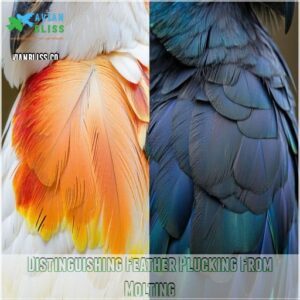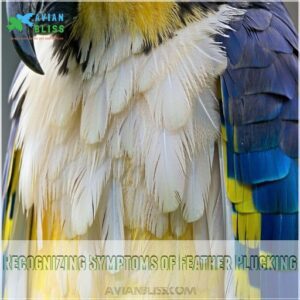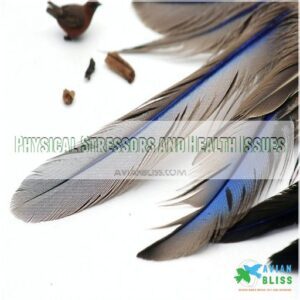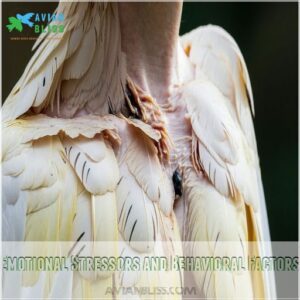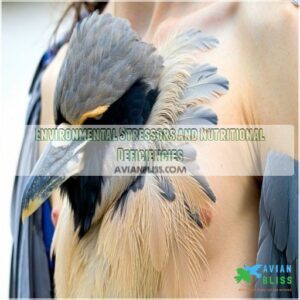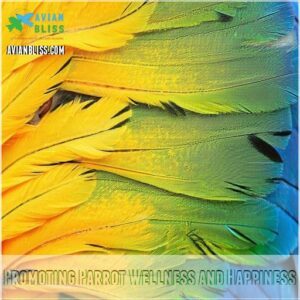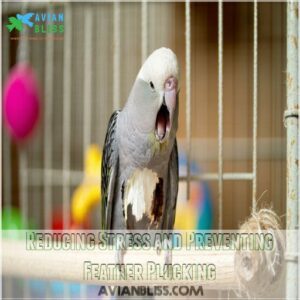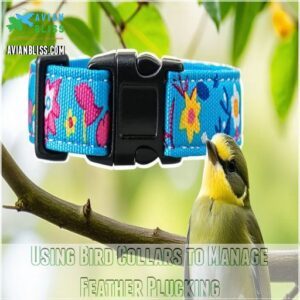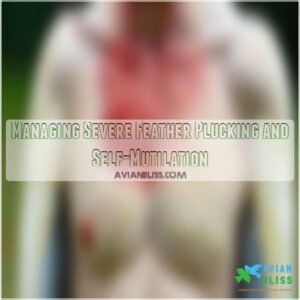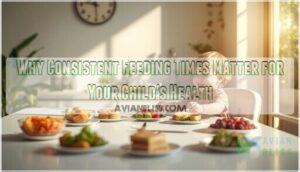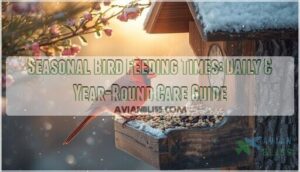This site is supported by our readers. We may earn a commission, at no cost to you, if you purchase through links.
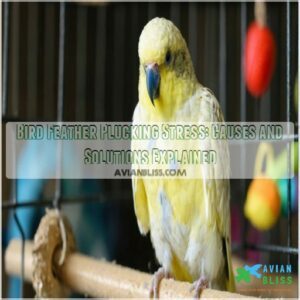
Birds—those delightful feathery brainiacs—crave interaction and mental challenges.
Imagine being stuck on a deserted island with nothing to do; you’d go stir-crazy, too!
Lack of stimulation or being lonely can lead to feather plucking as a misguided coping mechanism.
Address it by enriching their environment with toys, ensuring a nutritious diet, and providing social interaction.
Sometimes, it’s like trying to calm a tornado!
Stay vigilant about changes in their behavior.
Curious about how to keep your feathered friend feeling fabulous?
Let’s dive deeper into balancing their wellbeing.
Table Of Contents
- Key Takeaways
- Identifying Feather Plucking in Birds
- Causes of Feather Plucking in Birds
- Promoting Parrot Wellness and Happiness
- Reducing Stress and Preventing Feather Plucking
- Evidence-Based Behavior Supports for Feather Plucking
- Using Bird Collars to Manage Feather Plucking
- Developing a Behavior Plan for Your Bird
- Managing Severe Feather Plucking and Self-Mutilation
- Frequently Asked Questions (FAQs)
- Can stress cause feather plucking in birds?
- What happens if a bird repeatedly plucks at its feathers?
- What causes feather plucking?
- What is feather plucking?
- Is feather plucking a normal avian activity?
- Is feather plucking a habit?
- Do birds pluck their feathers when stressed?
- Why does my bird keep plucking his feathers?
- Can birds recover from feather plucking?
- Do bird feathers fall out when stressed?
- How does weather affect feather plucking behavior?
- Can feather plucking be triggered by loud noises?
- What role does genetics play in feather plucking?
- Are specific bird species more prone to plucking?
- How can changes in diet impact plucking habits?
- Conclusion
Key Takeaways
- Keep your bird’s environment stimulating with toys and social interactions to prevent boredom and stress-induced feather plucking.
- Provide a balanced diet rich in nutrients to support your bird’s overall health and reduce the likelihood of plucking.
- Observe your bird closely to spot signs of feather plucking early, and consult an avian vet for underlying health issues.
- Implement behavior modification techniques, like positive reinforcement, to encourage healthy grooming habits and reduce stress.
Identifying Feather Plucking in Birds
You’ll want to distinguish feather plucking from normal molting, as plucking involves signs of stress or compulsive behavior, unlike regular feather replacement.
Spotting chewed or broken feathers and observing unusual grooming habits can help determine if your bird’s just sprucing up or needs a little extra TLC.
Distinguishing Feather Plucking From Molting
Spotting the difference between feather plucking and molting helps maintain your bird’s well-being. Here’s how:
- Feather Quality: Molting naturally replaces old feathers; plucking damages feather quality.
- Feather Loss Patterns: Molting follows a predictable cycle, unlike haphazard plucking behavior.
- Skin Condition: Plucking often leaves irritated skin, unlike the healthier skin seen during molting.
Understanding these can ease bird stress and prevent feather destruction.
Recognizing Symptoms of Feather Plucking
When your bird starts resembling a plucked feather duster, it’s time to look closer.
Watch for feather loss, unusual skin changes, or evidence of beak chewing.
These signs often hint at stress or anxiety.
Wing damage or unusual plucking patterns could also mean your feathered friend needs help.
Understanding these symptoms empowers you to safeguard their happiness and health.
Behavioral Patterns of Feather Plucking
Understanding feather plucking patterns can shed light on your bird’s stress levels.
Notice the feather plucking frequency and intensity—these behavioral patterns may hint at anxiety or discomfort.
Managing plucking behavior requires patience and the right tools, such as effective plucking solutions.
If plucking is repetitive or occurs in specific locations, it could signal deeper issues.
Pay attention to plucking duration and changes in bird behavior; they can reveal stress and anxiety triggers.
Causes of Feather Plucking in Birds
Understanding why your feathered friend might start plucking can feel as complex as deciphering a bird’s chirp symphony.
Stress from health concerns, emotional upheavals, or even a dull environment can play a big part in this pesky habit, making your parrot feel like they’re starring in their own melodrama.
Physical Stressors and Health Issues
Beyond the emotional stuff, physical problems can also trigger feather plucking.
Think of it like this: if you’d a terrible toothache, you wouldn’t exactly be feeling your best, right?
Similarly, parasite infections, nutritional deficiencies, or an underlying illness can make your feathered friend miserable.
A visit to an avian vet can pinpoint the problem.
Proper bird nutrition and a balanced bird diet are key.
Early diagnosis and pain management are essential.
Emotional Stressors and Behavioral Factors
Imagine your feathered friend stuck in a soap opera of boredom and loneliness.
Anxiety and frustration take center stage, leading to emotional distress like depression.
Perhaps they miss a flock or feel the sting of loss.
Birds need engagement, not empty cages.
Spice up their lives with puzzles, and you’ll see their fears fly away, minimizing the plucking drama.
Environmental Stressors and Nutritional Deficiencies
Imagine a parrot cramped in a tiny cage with poor diet quality and limited water access. It’s a recipe for stress meltdown.
Noise levels that rival a rock concert, irregular light exposure, and lackluster environmental enrichment can lead to feather plucking.
Captivity’s physical environment plays a huge part.
Optimize cage size, improve diet, and create a calm sanctuary to combat nutritional deficiencies and stress.
Promoting Parrot Wellness and Happiness
To keep your parrot perched on the path to happiness, focus on providing a balanced diet, enriching environment, and plenty of social interaction.
Social interaction and a balanced diet are crucial for a happy parrot.
Think of it this way: a well-fed, entertained, and socially active bird is less likely to pluck its feathers and more likely to sing you a happy tune!
Providing a Balanced Diet and Nutrition
Tackling feather plucking stress? Keep your bird chirping with a balanced diet. A healthy food for birds should include a variety of nutrient-rich foods to address nutritional needs.
Address nutritional needs with varied foods, and don’t forget the healthy treats!
Consider supplement use if you spot nutritional deficiencies.
Regularly check with an avian vet for parrot wellness and diet changes.
A healthy bird diet is the cornerstone of happiness.
- High-quality pellets
- Fresh fruits
- Nutritious veggies
- Whole grains
- Seeds in moderation
Offering Environmental Enrichment and Stimulation
To keep your bird’s spirits high and those pesky feather plucking habits at bay, try crafting a lively habitat.
Foraging toys and puzzle feeders—think of them as the bird’s equivalent to puzzle boxes.
Sprinkle in some bird-safe plants and swinging perches.
These interactive activities serve as a delightful distraction, easing boredom and stress.
Encouraging Social Interaction and Exercise
Creating opportunities for your bird’s social interaction and exercise is like giving them a home gym with friends.
Birds thrive in playgroups where flock dynamics offer enrichment.
Make sure safe playtime with:
- Regular exercise routines
- Engaging enrichment toys
- Stress-free social interaction
- Observing bird behavior
- Preventing feather plucking
These steps keep your feathered pal content and healthy!
Reducing Stress and Preventing Feather Plucking
You can greatly reduce your feathered friend’s stress by creating a calm, enriching environment.
Think comfy perches, plenty of toys, and maybe even a little bird-friendly spa music – less stress means less plucking!
Creating a Stress-Free Environment
Imagine your bird’s sanctuary—a safe, quiet space with thoughtful cage design and enrichment toys.
Keep annoying noise pollution at bay while letting in natural light to soothe its soul.
Offer environmental enrichment to counter social isolation, and don’t forget about humidity, creating a cozy retreat.
Give your feathered friend the freedom to fly stress-free, thriving in harmony.
| Element | Description |
|---|---|
| Safe, Quiet Space | Limits stress and noise |
| Enrichment Toys | Boosts mental engagement |
| Natural Light | Encourages natural behaviors |
Managing Pain and Discomfort
Handling your bird’s pain is important for stress reduction and feather plucking prevention.
Keep a keen eye for discomfort signs—limping or unusual quietness may signal issues.
Imagine it like a mystery to solve: unraveling the clues with regular vet checkups helps prevent injury.
Effective pain management and relief can be your secret weapons in providing comforting and consistent veterinary care.
Providing Adequate Sleep and Rest
While managing pain keeps your bird comfy, don’t overlook the power of a good snooze.
Keep a consistent sleep schedule with cozy nighttime routines to curb feather plucking stress.
Tailor the sleep environment to reduce sleep deprivation, ensuring your bird feels rested and less antsy.
With better resting habits, you’re giving your bird a stress-free sanctuary.
Evidence-Based Behavior Supports for Feather Plucking
You can tackle feather plucking in your bird by using evidence-based behavior supports like Applied Behavior Analysis (ABA) therapy and reinforcement strategies.
These techniques will help curb the habit, and they’ll also empower you to become your bird’s behavior superhero—no cape needed.
Applied Behavior Analysis (ABA) Therapy
Think of ABA therapy for birds as a detective uncovering the mystery behind feather plucking.
This evidence-based method evaluates the environmental clues and habits causing your bird’s stress.
Crafting strategies from these insights allows for precise bird behavior modification.
Careful consideration ensures that each step is bird-friendly, paving paths to those ABA success stories you’re aiming for!
Positive Reinforcement Techniques
Positive reinforcement techniques can transform your feathered friend’s behavior.
Picture a bird gradually embracing new habits with a reward system design.
Using clicker training, reinforce positive actions like preening, while ignoring feather plucking.
Keep your positive reinforcement schedule steady to shape behaviors effectively.
Parrot training through rewards enhances bird behavior but also deepens your bond.
Differential Reinforcement Strategies
Rewarding good behavior is key.
Instead of just ignoring plucking, actively reward preening or playing with toys, especially when your bird exhibits signs of deep trust and affection.
This is differential reinforcement: boosting what you want, while gently fading out the plucking.
Think of it as shaping your bird’s behavior, one tiny step at a time.
Consistent reward systems make a big difference. It’s like training a puppy, but with feathers!
Using Bird Collars to Manage Feather Plucking
When your feathery friend insists on turning into a naked chicken impressionist, bird collars can be a temporary lifesaver, interrupting their plucking habit while you tackle the root causes.
These collars aren’t a magical fix, but they can buy you time to create a more harmonious environment.
Benefits and Limitations of Bird Collars
Bird collars can be a double-edged sword in managing feather plucking.
They’re effective at interrupting the plucking cycle but won’t solve the root issues, which can be complex and multifaceted, often tied to underlying causes of plucking.
Safe and well-fitted, they provide temporary relief while other strategies take hold.
Think of them as a band-aid—helpful yet limited.
Make sure your bird is comfortable, regularly checking for signs of irritation or stress.
Choosing The Right Bird Collar
You’ve weighed the benefits, now let’s talk about choosing the right bird collar to tackle feather plucking. Here’s your checklist:
- Collar Types: Opt for soft, comfortable materials that won’t irritate your bird.
- Size Fit: Make sure it’s snug but not too tight, allowing natural movement.
- Collar Adjustment: Adapt it as needed, observing bird behavior for stress signs.
Monitoring for Discomfort and Skin Irritation
After picking the perfect collar, keep an eye on your bird for any discomfort.
Collar fitting is key—check for irritation signs like redness or chafing.
Adjustments might be needed to help promote feather regrowth and maintain skin health.
A little vigilance goes a long way in ensuring your feathered friend stays comfy and pluck-free, boosting overall bird health.
Developing a Behavior Plan for Your Bird
Creating a behavior plan for your bird can feel like solving a feathery mystery, but it’s essential for managing feather plucking.
By identifying triggers, setting clear goals, and regularly evaluating your strategies, you’ll help your bird find relief and regain its vibrant plumage.
Identifying Triggers and Patterns
Spotting the triggers for your bird’s feather picking is like playing detective.
Watch for patterns: Is it a morning ritual or a post-dinner habit?
Look at the feather types and body areas most affected.
Tune into the context—stressful situations or boredom?
Understanding these clues in your bird’s behavior helps pinpoint the causes of feather plucking stress.
Setting Goals and Objectives
Now that you’ve identified your bird’s plucking triggers, let’s set some realistic goals. Think of it like a roadmap to a happier, healthier bird! What small, achievable steps can you take?
To help you explore different options, consider browsing bird enrichment products that cater to various bird species and needs.
- Behavior goals: Reduce plucking frequency by 25% in one month.
- Realistic expectations: Don’t expect overnight miracles; progress takes time.
- Tracking progress: Use a simple chart to monitor plucking.
- Intervention methods: Explore different enrichment toys.
- Long-term vision: A feather-full, stress-free future for your feathered friend!
Implementing and Evaluating The Plan
Building a plan’s like crafting a recipe for success.
Start with data collection on your bird’s habits.
Use a table to manage tasks:
| Action | Frequency | Success Metric |
|---|---|---|
| Environmental changes | Weekly | Happiness level |
| Behavioral therapy | Daily | Feather growth |
| Plan adjustments | Monthly | Stress reduction |
Keep tracking progress to tweak and adapt for long-term goals.
Managing Severe Feather Plucking and Self-Mutilation
When your feathered friend starts playing barber and things get out of hand, you’ve got to step in with support and care.
Recognizing signs of self-mutilation and seeking professional help can transform your bird’s life—and yours—into a harmonious duet.
Recognizing Signs of Self-Mutilation
Notice if your feathered friend is displaying feather loss, bleeding, or wounds—these can be dark clouds on the horizon of their well-being.
Self-mutilation isn’t just about vanity but signals deeper stress and anxiety.
Underlying health issues like parasite infections and liver disease can also be contributing factors.
Watch for signs like skin irritation or persistent self-harm behavior.
Addressing these issues swiftly helps prevent further damage and aids in reclaiming your bird’s comfort and happiness.
Seeking Professional Help and Guidance
When your bird’s feather plucking becomes a serious issue, consider reaching out to a certified avian vet or bird behaviorist.
These specialists know all about feather plucking causes and can guide you through effective treatment options.
Don’t hesitate to join support groups; they’ll provide comfort and shared wisdom from others facing similar parrot behavior problems.
Providing a Safe and Supportive Environment
Your bird’s doing a Houdini in its cage? It’s time to think big—literally. Opt for a spacious cage with diverse perch options and safe toys, ensuring you choose the right parrot cage size for your feathered friend.
Introduce bird-friendly plants for a dash of nature.
Create a quiet space for relaxation, reducing feather plucking stress.
These tweaks in environment enhance parrot wellness, crafting a haven for stress management.
Frequently Asked Questions (FAQs)
Can stress cause feather plucking in birds?
Absolutely, stress can lead to feather plucking in birds.
It’s like when you’re so bored you start biting your nails—stress, boredom, or even diet issues can leave your feathery friend needing help and care.
What happens if a bird repeatedly plucks at its feathers?
If a bird frequently nibbles at its own feathers, it can create bald patches, leading to skin infections or self-harm.
Stress relief and maybe a vet consult are needed.
What causes feather plucking?
Feather plucking’s a tough one!
It’s often stress, boredom, or even a hidden health problem.
Think of it like a bird’s way of saying, "Something’s not right!"
A vet checkup’s your first step.
What is feather plucking?
Imagine this: your bird obsessively pulling at its own feathers, leaving bald spots.
It’s called feather plucking, often triggered by stress or boredom.
Address underlying issues with enrichment and vet care to nip it in the bud.
Is feather plucking a normal avian activity?
You might think feather plucking is just a quirky parrot habit, but it’s not typical.
It signals stress or health issues.
Think of it as their way of waving a little flag for help.
Is feather plucking a habit?
Habits are hard to break, and feather plucking can indeed become one.
It’s often a coping mechanism for birds dealing with stress, boredom, or underlying health issues.
Which can be challenging to overcome without the right guidance.
Do birds pluck their feathers when stressed?
Ever wondered why bird feathers scatter across the cage floor?
Stress might be the culprit.
When anxiety strikes, birds can turn to feather plucking, seeking an escape.
Make sure your feathered friend’s environment is calm and enriching.
Why does my bird keep plucking his feathers?
Feather plucking can signal stress, boredom, or health issues.
Enrich your bird’s environment with toys and activities, ensuring a balanced diet, and consulting a vet to rule out medical causes.
Engage and nurture your feathery friend!
Can birds recover from feather plucking?
Imagine your bird’s feathers as a garden; with care, they can flourish again. Yes, recovery’s possible! Early intervention and addressing the root cause are key for a full recovery.
Do bird feathers fall out when stressed?
When a bird faces stress, its feathers don’t simply fall out.
While molting is natural, stress might trigger over-preening or feather plucking, leading to feather loss as a symptom of deeper anxiety or health issues.
How does weather affect feather plucking behavior?
Weather changes, like a rollercoaster ride, can ramp up feather plucking.
Humidity or temperature shifts mess with your bird’s comfort, triggering stress.
Make sure you’ve got their environment dialed in for consistent conditions and reduced anxiety.
Can feather plucking be triggered by loud noises?
Yes, loud noises can trigger feather plucking in birds by causing stress and anxiety.
Imagine your bird’s world suddenly filled with clamor, leading to nervous habits like plucking.
A calm, quiet environment helps prevent this behavior.
What role does genetics play in feather plucking?
Genetics, though not the main culprit, can sometimes add fuel to the fire of feather plucking in birds.
Certain species may inherit traits making them more prone to stress responses, including plucking, under challenging environmental conditions.
Are specific bird species more prone to plucking?
Parrots such as African Greys, Cockatoos, and Macaws often fall into the feather plucking trap, thanks to their high intelligence and need for stimulation.
When bored or stressed, they pluck, much like a restless artist without a canvas.
How can changes in diet impact plucking habits?
Imagine feeling hungry but only getting junk food.
Birds need balanced diets too!
A healthier diet reduces stress, improving your feathered friend’s mood and decreasing plucking.
Add fresh veggies and quality pellets for happier, prettier plumage.
Conclusion
So, you’ve learned about bird feather plucking stress; what’s next?
Remember, understanding the root causes—whether it’s boredom, a health issue, or nutritional deficiency—is key.
Addressing bird feather plucking stress involves creating a stimulating environment, providing a balanced diet, and plenty of social interaction.
Don’t hesitate to seek veterinary advice if the plucking is severe.
With patience and the right approach, you can help your feathered friend feel happier and healthier, reducing that bird feather plucking stress.
Early intervention is important, so keep a close eye on your bird’s behavior.

